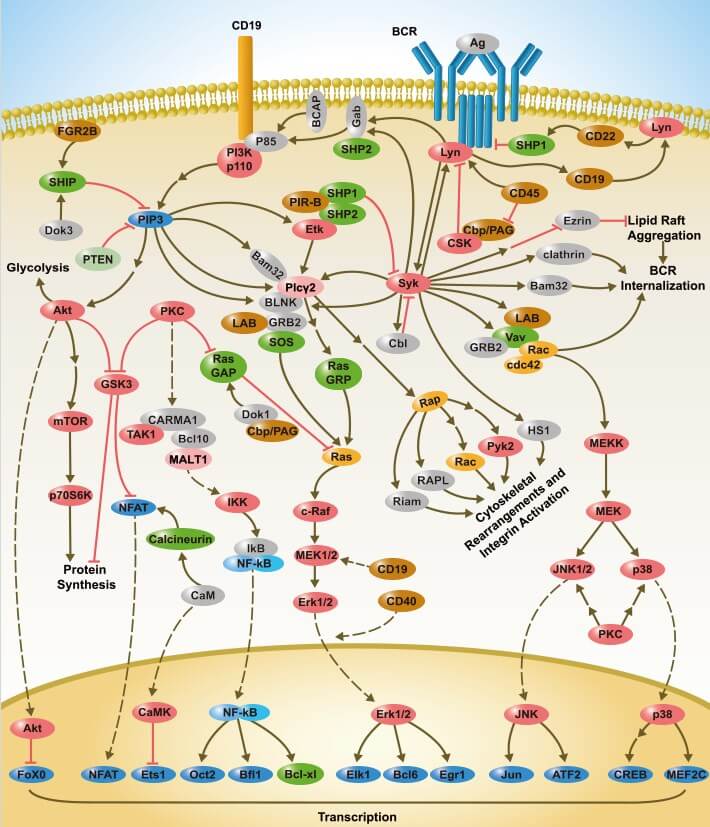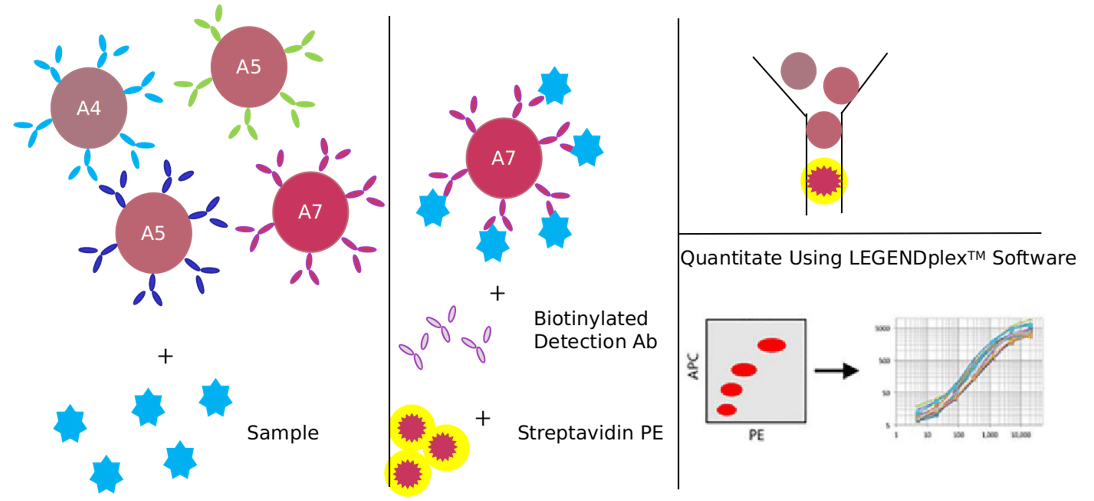B cell receptor signaling pathway
Based on Luminex technology platform, Creative Proteomics provides analysis services for key targets of B cell receptor signaling pathway.
Functional B cell receptors are multi-protein complexes composed of antigen-binding subunits and signal transduction subunits. The B cell antigen receptor (BCR) is composed of cell membrane immunoglobulin (mIg) molecules and related Igα/Igβ (CD79a/CD79b) heterodimers (α/β). The mIg subunit binds to the antigen, leading to receptor aggregation, while the α/β subunit transmits the signal to the inside of the cell. After BCR accumulates, it rapidly activates the Src family kinases Lyn, Blk and Fyn, and the tyrosine kinases Syk and Btk.
Signals from signal bodies activate multiple signal cascades, including kinases, GTPases, and transcription factors. This will lead to changes in cell metabolism, gene expression and cytoskeletal structure. The complexity of BCR signal transduction can lead to many distinct outcomes, including survival, tolerance (disability) or apoptosis, proliferation, and differentiation into antibody-producing cells or memory B cells. The outcome of the response is determined by many factors, including the mature state of the cell, antigenic properties, the scope and duration of BCR signal transduction, and signals from other receptors (such as CD40, IL-21 receptor, and BAFF-R). Many other transmembrane proteins, some of which are also receptors, can modulate specific parts of BCR signal transduction. Some of these transmembrane proteins include CD45, CD19, CD22, PIR-B and FcγRIIB1 (CD32), which are marked in yellow here. The scope and duration of BCR signal transduction are limited by the negative feedback loop, which includes Lyn/CD22/SHP-1 pathway, Cbp/Csk pathway, SHIP, Cbl, Dok-1, Dok-3, FcγRIIB1, PIR-B And internalization of BCR.
In vivo, B cells are usually captured by antigen-expressing cells and activated after exposure of the cell surface. Activation of B cells by this membrane-associated antigen requires BCR-induced cytoskeletal remodeling. In recent years, B-cell receptor signaling pathways have been widely used in many biologic drugs and small molecule drugs in the field of B-cell lymphoma treatment.

Our detectable targets:
| SHP2 | PIP3 | FGR2B | Lyn | CD22 | CD19 |
| CD45 | PIR-B | Etk | PTEN | Dok3 | Akt |
| PKC | LAB | SOS | Plcy2 | Syk | CSK |
| cdc42 | GSK3 | TAK1 | NFκB | NFAT | c-Raf |
| JNK1 | JNK2 | MEK1 | p85 | Erk1 | Erk2 |
| CaM | CD40 | MEK2 | p38 | SHIP | JNK |
| IKK | HS1 | IkB | p70S6K | Cbl | HS1 |
| mTOR | Vav | PI3K | p110 | Rap | MEKK |
Technology platform
We provide Luminex technology for B cell receptor signaling pathway analysis.
Luminex technology is a multifunctional liquid phase analysis platform developed on the basis of colored microspheres, laser technology, applied fluidics and high-speed digital signal processing technology. The core is to encode polypropylene microspheres or magnetic microspheres with fluorescent dyes. By adjusting the different ratios of the two fluorescent dyes, up to 100 microspheres with different fluorescence spectra can be obtained. Each kind of microspheres is covalently cross-linked. Capture antibodies against specific antigens.
B cells are usually captured by antigen-expressing cells and activated after exposure of the cell surface. The B cell receptor signaling pathway is widely used in many biological drugs and small molecule drugs in the field of B cell lymphoma treatment.
In addition to Luminex Multiplex Assay, Enzyme-linked immunosorbent assay (ELISA), Flow cytometry (FACS analysis) technology can also be provided to meet other customer needs.
Advantages of B cell receptor signaling pathway detection:
- Versatility: VEGF signaling pathway technology can be applied to a variety of biological tests, including immune analysis, genotyping, gene expression, enzyme analysis, etc. It can detect both protein and nucleic acid. In addition to clinical use, it can also be used in scientific research, CDC, blood stations, agricultural, biological and pharmaceutical professional laboratories.
- High-throughput and high-speed: Each microsphere is used as a separate test body, which can perform a large number of biological tests at the same time. It only needs 10~201 samples to test up to 100 indicators at a time, and the fastest can reach 10,000 tests /hour.

Application of our service:
- To study the effects of drugs or therapies on B cell receptor signaling pathways
- To study the effect of each virus on B cell receptor signaling pathway
- To study the regulation mechanism of B cell receptor signaling pathway in disease
Creative Proteomics has developed a signal pathway target detection platform. We are not limited to providing B cell receptor signaling path detection services, but can also provide other signal path detection services. If you want to detect other targets, please contact us and we will customize the service for you. Look forward to working with you.
References:
- Dal Porto JM, Gauld SB,et al. B cell antigen receptor signaling 101. Mol. Immunol, 2018, 41(6-7): 599–613.
- Goodnow CC, Vinuesa CG, et al. Control systems and decision making for antibody production. Nat. Immunol, 2019, 11(8): 681–688.
- Harwood NE, Batista FD. Early events in B cell activation. Annu. Rev. Immunol, 2019, 28: 185–210.



